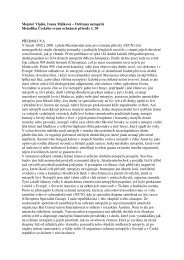Venkovská krajina 2008 - Veronica
Venkovská krajina 2008 - Veronica
Venkovská krajina 2008 - Veronica
Create successful ePaper yourself
Turn your PDF publications into a flip-book with our unique Google optimized e-Paper software.
To render the second wave of suburbanization which took place after 2002 (Ouředníček,<br />
Posová 2006), it will be necessary to wait for the release of an updated database CLC 2006.<br />
With respect to the above mentioned facts, it is possible to state analyses of changes in<br />
urban<br />
areas included in the CLC database by several methods:<br />
1. increase in urban area expressed in administrative units (Bičík & Kupková, 2006;<br />
Hasse & Lathrop, 2003)<br />
2. increase in urban area expressed in reference to a regular net (Poudevigne, 1997)<br />
3. assessment of a change in urban areas by means of suitable indicators in certain<br />
spatial units (kol. 2006)<br />
Information on localization and a process range is crucial to an impact assessment; in<br />
addition, it provides us with information where this transformation happens.<br />
Methodology<br />
The aim of this paper was to map a spatial pattern of the first wave of suburbanization in<br />
the Czech Republic. For comparison, the approach assessing a change in terms of<br />
administrative units as well as the approach of assessing a change in a regular net was used.<br />
Data on categories of urban areas were exported from the CORINE Land Cover database<br />
from the years 1990 and 2000 and these categories were consequently configurated into the<br />
categories<br />
rendering commercial and residential sub/urbanization. In the first category the<br />
continuous and discontinuous urban house-building was involved (codes 111,112 of the<br />
CLC nomenclature); and the second category contains industrial or commercial zones,<br />
public road and railway systems with neighbouring areas, airports, sport and recreational<br />
facilities (codes 121,122,124,142 of the CLC nomenclature). As a reference base of<br />
municipal boundaries the layer from ARC ČR 500 was used and a net mesh-sized 1km<br />
ar<br />
2 was<br />
created for assessment in a regular net. Areas of two tracked categories were calculated for<br />
single municipalities and meshes and these were expressed relatively in reference to a unit<br />
ea in per cent. The data were analysed and the results visualised by the help of ArcGIS<br />
9.2 tools.<br />
on<br />
d<br />
sh ed<br />
dential suburbanization increased in 2000 by 50 km 2 Results and discussi<br />
The ata analysis from CORINE Land Cover dated from the years 1990 and 2000<br />
ow an increase in commercial and residential areas in a similar amount. The area<br />
expanse reflecting the resi<br />
compared to<br />
1990.<br />
The area expanse reflecting the commercial suburbanization increased by 42 km<br />
ned territories.<br />
While in the event of residential suburbanization the highest increase was logically noticed<br />
n s, in case of commercial suburbanization the logistically favourable<br />
lo<br />
2 .<br />
We will though find the differences in the spatial distribution of the mentio<br />
ear the big citie<br />
cation of new constructed premises became a significant factor. In both cases the most<br />
significant increase in suburban areas was noticed in the rear of Prague where this process<br />
was also the most frequently examined and described. The first wave of residential<br />
suburbanization became also evident together with the outskirts of Prague in its southern<br />
surroundings with attractive landscape; the synonyms of this development were the<br />
municipalities of Jesenice, Průhonice or Dobřejovice. Significant changes in construction<br />
area were also noticed p.e. in the land registrers in Hostivice, Rudná, Řitka, Líbeznice,<br />
Šestajovice and in a number of others all over the Prague territory. Such significant changes<br />
– an increase in residential areas over 15% - have not happened in the rear of any other big<br />
cities. But the process of sub/urbanization have not been naturally avoided on the outskirts<br />
and surroundings of Brno, Ostrava, Plzeň and České Budějovice, nevertheless it did not




